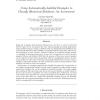Free Online Productivity Tools
i2Speak
i2Symbol
i2OCR
iTex2Img
iWeb2Print
iWeb2Shot
i2Type
iPdf2Split
iPdf2Merge
i2Bopomofo
i2Arabic
i2Style
i2Image
i2PDF
iLatex2Rtf
Sci2ools
NLE
2008
2008
Using automatically labelled examples to classify rhetorical relations: an assessment
Being able to identify which rhetorical relations (e.g., contrast or explanation) hold between spans of text is important for many natural language processing applications. Using machine learning to obtain a classifier which can distinguish between different relations typically depends on the availability of manually labelled training data, which is very time-consuming to create. However, rhetorical relations are sometimes lexically marked, i.e., signalled by discourse markers (e.g., because, but, consequently etc.), and it has been suggested (Marcu and Echihabi, 2002) that the presence of these cues in some examples can be exploited to label them automatically with the corresponding relation. The discourse markers are then removed and the automatically labelled data are used to train a classifier to determine relations even when no discourse marker is present (based on other linguistic cues such as word co-occurrences). In this paper, we investigate empirically how feasible this appr...
| Added | 14 Dec 2010 |
| Updated | 14 Dec 2010 |
| Type | Journal |
| Year | 2008 |
| Where | NLE |
| Authors | Caroline Sporleder, Alex Lascarides |
Comments (0)

